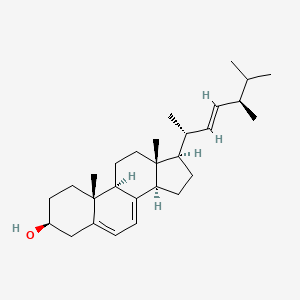| MeSH term | MeSH ID | Detail |
|---|---|---|
| Hemolysis | D006461 | 131 associated lipids |
| Leishmaniasis | D007896 | 19 associated lipids |
| Tinea | D014005 | 5 associated lipids |
| Mycoses | D009181 | 18 associated lipids |
Ergosterol
Ergosterol is a lipid of Sterol Lipids (ST) class. Ergosterol is associated with abnormalities such as Disintegration (morphologic abnormality), Consumption-archaic term for TB, Candidiasis, Mycoses and Iodotyrosyl coupling defect. The involved functions are known as Anabolism, sporulation, 5-(carboxyamino)imidazole ribonucleotide mutase activity, Subtraction process and Physiologic Organization. Ergosterol often locates in Pore, Membrane, Protoplasm, Plasma membrane and Endoplasmic Reticulum. The associated genes with Ergosterol are IMPACT gene, BLVRB gene, CYP51A1 gene, CDR1 wt Allele and HM13 gene. The related lipids are Sterols, Cardiolipins, Membrane Lipids, fecosterol and Phosphatidylserines. The related experimental models are Knock-out.
Cross Reference
Introduction
To understand associated biological information of Ergosterol, we collected biological information of abnormalities, associated pathways, cellular/molecular locations, biological functions, related genes/proteins, lipids and common seen animal/experimental models with organized paragraphs from literatures.
What diseases are associated with Ergosterol?
Ergosterol is suspected in Infection, Mycoses, Candidiasis, Chagas Disease, Cyst, Dermatophytosis and other diseases in descending order of the highest number of associated sentences.
Related references are mostly published in these journals:
| Disease | Cross reference | Weighted score | Related literature |
|---|
Possible diseases from mapped MeSH terms on references
We collected disease MeSH terms mapped to the references associated with Ergosterol
PubChem Associated disorders and diseases
What pathways are associated with Ergosterol
Lipid pathways are not clear in current pathway databases. We organized associated pathways with Ergosterol through full-text articles, including metabolic pathways or pathways of biological mechanisms.
Related references are published most in these journals:
| Pathway name | Related literatures |
|---|
PubChem Biomolecular Interactions and Pathways
Link to PubChem Biomolecular Interactions and PathwaysWhat cellular locations are associated with Ergosterol?
Visualization in cellular structure
Associated locations are in red color. Not associated locations are in black.
Related references are published most in these journals:
| Location | Cross reference | Weighted score | Related literatures |
|---|
What functions are associated with Ergosterol?
Related references are published most in these journals:
| Function | Cross reference | Weighted score | Related literatures |
|---|
What lipids are associated with Ergosterol?
Related references are published most in these journals:
| Lipid concept | Cross reference | Weighted score | Related literatures |
|---|
What genes are associated with Ergosterol?
Related references are published most in these journals:
| Gene | Cross reference | Weighted score | Related literatures |
|---|
What common seen animal models are associated with Ergosterol?
Knock-out
Knock-out are used in the study 'Multidrug transporters CaCdr1p and CaMdr1p of Candida albicans display different lipid specificities: both ergosterol and sphingolipids are essential for targeting of CaCdr1p to membrane rafts.' (Pasrija R et al., 2008) and Knock-out are used in the study 'UPC2A is required for high-level azole antifungal resistance in Candida glabrata.' (Whaley SG et al., 2014).
Related references are published most in these journals:
| Model | Cross reference | Weighted score | Related literatures |
|---|
NCBI Entrez Crosslinks
All references with Ergosterol
Download all related citations| Authors | Title | Published | Journal | PubMed Link |
|---|---|---|---|---|
| Zielińska J et al. | Thermodynamics and kinetics of amphotericin B self-association in aqueous solution characterized in molecular detail. | 2016 | Sci Rep | pmid:26742886 |
| Song XS et al. | An antibody that confers plant disease resistance targets a membrane-bound glyoxal oxidase in Fusarium. | 2016 | New Phytol. | pmid:26720747 |
| Yoshioka M et al. | The fungicidal activity of amphotericin B requires autophagy-dependent targeting to the vacuole under a nutrient-starved condition in Saccharomyces cerevisiae. | 2016 | Microbiology (Reading, Engl.) | pmid:26940206 |
| Neumann A et al. | Membrane Sterols Modulate the Binding Mode of Amphotericin B without Affecting Its Affinity for a Lipid Bilayer. | 2016 | Langmuir | pmid:27007267 |
| Valdez-Morales M et al. | Phenolic Compounds, Antioxidant Activity and Lipid Profile of Huitlacoche Mushroom (Ustilago maydis) Produced in Several Maize Genotypes at Different Stages of Development. | 2016 | Plant Foods Hum Nutr | pmid:27605221 |
| Oblak E et al. | Quaternary ammonium salt N-(dodecyloxycarboxymethyl)-N,N,N-trimethyl ammonium chloride induced alterations in Saccharomyces cerevisiae physiology. | 2016 | J. Biosci. | pmid:27966483 |
| Fernando D et al. | Cytotoxic effects of ergone, a compound isolated from Fulviformes fastuosus. | 2016 | BMC Complement Altern Med | pmid:27887609 |
| Dauchy FA et al. | Trypanosoma brucei CYP51: Essentiality and Targeting Therapy in an Experimental Model. | 2016 | PLoS Negl Trop Dis | pmid:27855164 |
| Belaunzarán ML | [Chagas disease: Globalization and new hope for its cure]. | 2015 Apr-Jun | Rev. Argent. Microbiol. | pmid:26028584 |
| Gutiérrez MS et al. | Molecular Characterization and Functional Analysis of Cytochrome b5 Reductase (CBR) Encoding Genes from the Carotenogenic Yeast Xanthophyllomyces dendrorhous. | 2015 | PLoS ONE | pmid:26466337 |
